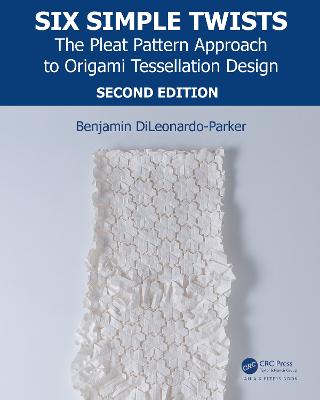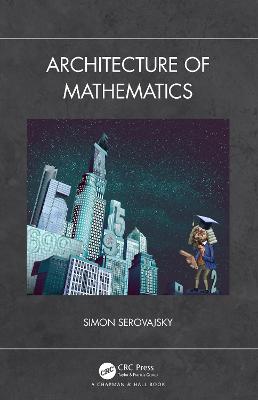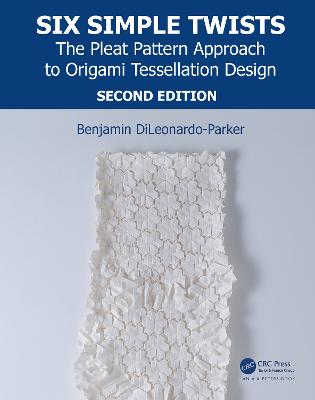Six Simple Twists
 -10%
portes grátis
-10%
portes grátis
Six Simple Twists
The Pleat Pattern Approach to Origami Tessellation Design
DiLeonardo-Parker, Benjamin
Taylor & Francis Ltd
09/2020
308
Mole
Inglês
9781138311886
15 a 20 dias
1066
Descrição não disponível.
Part I
1.00 - Why Study Pleat Patterns?
1.01 - Basics and Preparation
1.02 - How Pleat Patterns Differ from Traditional Origami
1.03 - How to Read the Diagrams and Fold Parity
1.04 - Folding Uniform Parallel Creases
1.05 - Grid Axes and How to Fold a Hexagon
1.06 - How to Fold a Triangle Grid
1.07 - Simple Pleat
1.08 - The Six Simple Twists
1.09 - Triangle Twist
1.10 - Triangle Spread
1.11 - Hex Twist
1.12 - Hex Spread
1.13 - Rhombic Twist
1.14 - Arrow Twist
1.15 - Anatomy of a Molecule
1.16 - Pleat Intersection Notation
Part II
2.00 - How to Use the Six Simple Twists
2.01 - 32nd's Grid
2.02 - Locking and Unlocking Pleats
2.03 - Triangle Twist Tessellation
2.04 - 3.6.3.6 Tessellation
2.05 - Tessellation Basics
2.06 - Applying Tessellation Knowledge Folding
2.07 - Triangle Weave Tessellation
2.08 - 3.6.3.6 Weave Tessellation
2.09 - 6.6.6 Hexagonal Failing Cluster
2.10 - Modifications
2.11 - Backtwisting
2.12 - Twist Handedness and Pleat Symmetry
2.13 - Pleat Flattening
2.14 - Triangle Twist Tessellation with Flattened Pleats
2.15 - Hidden Circles Pattern
2.16 - Rhombic Twist Tessellation
2.17 - Rhombic Twist Variants
2.18 - Twist Sinking
2.19 - Twist Expansion
2.20 - Nub Offset Tessellation
2.21 - Shift Rosette Tessellation
2.22 - Ridge Creation
2.23 - Button Molecule
2.24 - Button Molecule Tessellation
2.25 - Triangle Flagstone Tessellation and Offsetting Pleats
2.26 - 3.6.3.6 Flagstone Tessellation
2.27 - Crooked Split
2.28 - Snowflake Tessellation
2.29 - Tulip Split
2.30 - Tulip Split Tessellation
2.31 - Molecule Size and Different Grid Densities
2.32 - "Front" and "Back" Sides
2.33 - Tendril Tessellation
2.34 - Inverting a Pleat
2.35 - Iso-Area Triangle Twist Tessellation
2.36. - Pleat Pushing
2.37 - Platform Tess
2.38 - Triple Twist Tess
Part III
3.00 - Pleat Patterns as Artwork
3.01 - Gallery
3.02 - Pleat-to-Molecule Analysis
3.03 - Twist Archetype Sets
3.04 - Molecule Database
3.05 - Archetype Composition
3.06 - Actions and Notation
3.07 - Splitting Equation
3.08 - Normal Polygon Models
3.09 - Circle Cutout Model
3.10 - Molecule-to-Pleat Analysis
3.11 - Sectioning Model of Perfect Twist Design
3.12 - Brocard Points
Final thoughts
Pleat Notation Thoughts By Matthew Benet
Glossary
1.00 - Why Study Pleat Patterns?
1.01 - Basics and Preparation
1.02 - How Pleat Patterns Differ from Traditional Origami
1.03 - How to Read the Diagrams and Fold Parity
1.04 - Folding Uniform Parallel Creases
1.05 - Grid Axes and How to Fold a Hexagon
1.06 - How to Fold a Triangle Grid
1.07 - Simple Pleat
1.08 - The Six Simple Twists
1.09 - Triangle Twist
1.10 - Triangle Spread
1.11 - Hex Twist
1.12 - Hex Spread
1.13 - Rhombic Twist
1.14 - Arrow Twist
1.15 - Anatomy of a Molecule
1.16 - Pleat Intersection Notation
Part II
2.00 - How to Use the Six Simple Twists
2.01 - 32nd's Grid
2.02 - Locking and Unlocking Pleats
2.03 - Triangle Twist Tessellation
2.04 - 3.6.3.6 Tessellation
2.05 - Tessellation Basics
2.06 - Applying Tessellation Knowledge Folding
2.07 - Triangle Weave Tessellation
2.08 - 3.6.3.6 Weave Tessellation
2.09 - 6.6.6 Hexagonal Failing Cluster
2.10 - Modifications
2.11 - Backtwisting
2.12 - Twist Handedness and Pleat Symmetry
2.13 - Pleat Flattening
2.14 - Triangle Twist Tessellation with Flattened Pleats
2.15 - Hidden Circles Pattern
2.16 - Rhombic Twist Tessellation
2.17 - Rhombic Twist Variants
2.18 - Twist Sinking
2.19 - Twist Expansion
2.20 - Nub Offset Tessellation
2.21 - Shift Rosette Tessellation
2.22 - Ridge Creation
2.23 - Button Molecule
2.24 - Button Molecule Tessellation
2.25 - Triangle Flagstone Tessellation and Offsetting Pleats
2.26 - 3.6.3.6 Flagstone Tessellation
2.27 - Crooked Split
2.28 - Snowflake Tessellation
2.29 - Tulip Split
2.30 - Tulip Split Tessellation
2.31 - Molecule Size and Different Grid Densities
2.32 - "Front" and "Back" Sides
2.33 - Tendril Tessellation
2.34 - Inverting a Pleat
2.35 - Iso-Area Triangle Twist Tessellation
2.36. - Pleat Pushing
2.37 - Platform Tess
2.38 - Triple Twist Tess
Part III
3.00 - Pleat Patterns as Artwork
3.01 - Gallery
3.02 - Pleat-to-Molecule Analysis
3.03 - Twist Archetype Sets
3.04 - Molecule Database
3.05 - Archetype Composition
3.06 - Actions and Notation
3.07 - Splitting Equation
3.08 - Normal Polygon Models
3.09 - Circle Cutout Model
3.10 - Molecule-to-Pleat Analysis
3.11 - Sectioning Model of Perfect Twist Design
3.12 - Brocard Points
Final thoughts
Pleat Notation Thoughts By Matthew Benet
Glossary
Este título pertence ao(s) assunto(s) indicados(s). Para ver outros títulos clique no assunto desejado.
Triangle Twist;Valley Folds;Mountain Folds;Origami Tessellation;Pleat Intersection;Parallel Pleat;Origami;Vice Versa;Geometric Origami;Simple Twists;Geometric Tessellations;CCW Direction;Folding;Crease Pattern;Gridding;Inverted Pleats;Visual qualities;Twist Tessellation;Origami tessellations;Normal Polygon;Drifting process;Global Location;Pleat patterns;Parallel Creases;Pleat intersections;Scalene Triangle;Triangle Grid;Additive Inverse;CCW;Polygon Twist;Hex Grid;Standing Form;Null Set;Grid Lines;Simple Flat Twists
Part I
1.00 - Why Study Pleat Patterns?
1.01 - Basics and Preparation
1.02 - How Pleat Patterns Differ from Traditional Origami
1.03 - How to Read the Diagrams and Fold Parity
1.04 - Folding Uniform Parallel Creases
1.05 - Grid Axes and How to Fold a Hexagon
1.06 - How to Fold a Triangle Grid
1.07 - Simple Pleat
1.08 - The Six Simple Twists
1.09 - Triangle Twist
1.10 - Triangle Spread
1.11 - Hex Twist
1.12 - Hex Spread
1.13 - Rhombic Twist
1.14 - Arrow Twist
1.15 - Anatomy of a Molecule
1.16 - Pleat Intersection Notation
Part II
2.00 - How to Use the Six Simple Twists
2.01 - 32nd's Grid
2.02 - Locking and Unlocking Pleats
2.03 - Triangle Twist Tessellation
2.04 - 3.6.3.6 Tessellation
2.05 - Tessellation Basics
2.06 - Applying Tessellation Knowledge Folding
2.07 - Triangle Weave Tessellation
2.08 - 3.6.3.6 Weave Tessellation
2.09 - 6.6.6 Hexagonal Failing Cluster
2.10 - Modifications
2.11 - Backtwisting
2.12 - Twist Handedness and Pleat Symmetry
2.13 - Pleat Flattening
2.14 - Triangle Twist Tessellation with Flattened Pleats
2.15 - Hidden Circles Pattern
2.16 - Rhombic Twist Tessellation
2.17 - Rhombic Twist Variants
2.18 - Twist Sinking
2.19 - Twist Expansion
2.20 - Nub Offset Tessellation
2.21 - Shift Rosette Tessellation
2.22 - Ridge Creation
2.23 - Button Molecule
2.24 - Button Molecule Tessellation
2.25 - Triangle Flagstone Tessellation and Offsetting Pleats
2.26 - 3.6.3.6 Flagstone Tessellation
2.27 - Crooked Split
2.28 - Snowflake Tessellation
2.29 - Tulip Split
2.30 - Tulip Split Tessellation
2.31 - Molecule Size and Different Grid Densities
2.32 - "Front" and "Back" Sides
2.33 - Tendril Tessellation
2.34 - Inverting a Pleat
2.35 - Iso-Area Triangle Twist Tessellation
2.36. - Pleat Pushing
2.37 - Platform Tess
2.38 - Triple Twist Tess
Part III
3.00 - Pleat Patterns as Artwork
3.01 - Gallery
3.02 - Pleat-to-Molecule Analysis
3.03 - Twist Archetype Sets
3.04 - Molecule Database
3.05 - Archetype Composition
3.06 - Actions and Notation
3.07 - Splitting Equation
3.08 - Normal Polygon Models
3.09 - Circle Cutout Model
3.10 - Molecule-to-Pleat Analysis
3.11 - Sectioning Model of Perfect Twist Design
3.12 - Brocard Points
Final thoughts
Pleat Notation Thoughts By Matthew Benet
Glossary
1.00 - Why Study Pleat Patterns?
1.01 - Basics and Preparation
1.02 - How Pleat Patterns Differ from Traditional Origami
1.03 - How to Read the Diagrams and Fold Parity
1.04 - Folding Uniform Parallel Creases
1.05 - Grid Axes and How to Fold a Hexagon
1.06 - How to Fold a Triangle Grid
1.07 - Simple Pleat
1.08 - The Six Simple Twists
1.09 - Triangle Twist
1.10 - Triangle Spread
1.11 - Hex Twist
1.12 - Hex Spread
1.13 - Rhombic Twist
1.14 - Arrow Twist
1.15 - Anatomy of a Molecule
1.16 - Pleat Intersection Notation
Part II
2.00 - How to Use the Six Simple Twists
2.01 - 32nd's Grid
2.02 - Locking and Unlocking Pleats
2.03 - Triangle Twist Tessellation
2.04 - 3.6.3.6 Tessellation
2.05 - Tessellation Basics
2.06 - Applying Tessellation Knowledge Folding
2.07 - Triangle Weave Tessellation
2.08 - 3.6.3.6 Weave Tessellation
2.09 - 6.6.6 Hexagonal Failing Cluster
2.10 - Modifications
2.11 - Backtwisting
2.12 - Twist Handedness and Pleat Symmetry
2.13 - Pleat Flattening
2.14 - Triangle Twist Tessellation with Flattened Pleats
2.15 - Hidden Circles Pattern
2.16 - Rhombic Twist Tessellation
2.17 - Rhombic Twist Variants
2.18 - Twist Sinking
2.19 - Twist Expansion
2.20 - Nub Offset Tessellation
2.21 - Shift Rosette Tessellation
2.22 - Ridge Creation
2.23 - Button Molecule
2.24 - Button Molecule Tessellation
2.25 - Triangle Flagstone Tessellation and Offsetting Pleats
2.26 - 3.6.3.6 Flagstone Tessellation
2.27 - Crooked Split
2.28 - Snowflake Tessellation
2.29 - Tulip Split
2.30 - Tulip Split Tessellation
2.31 - Molecule Size and Different Grid Densities
2.32 - "Front" and "Back" Sides
2.33 - Tendril Tessellation
2.34 - Inverting a Pleat
2.35 - Iso-Area Triangle Twist Tessellation
2.36. - Pleat Pushing
2.37 - Platform Tess
2.38 - Triple Twist Tess
Part III
3.00 - Pleat Patterns as Artwork
3.01 - Gallery
3.02 - Pleat-to-Molecule Analysis
3.03 - Twist Archetype Sets
3.04 - Molecule Database
3.05 - Archetype Composition
3.06 - Actions and Notation
3.07 - Splitting Equation
3.08 - Normal Polygon Models
3.09 - Circle Cutout Model
3.10 - Molecule-to-Pleat Analysis
3.11 - Sectioning Model of Perfect Twist Design
3.12 - Brocard Points
Final thoughts
Pleat Notation Thoughts By Matthew Benet
Glossary
Este título pertence ao(s) assunto(s) indicados(s). Para ver outros títulos clique no assunto desejado.
Triangle Twist;Valley Folds;Mountain Folds;Origami Tessellation;Pleat Intersection;Parallel Pleat;Origami;Vice Versa;Geometric Origami;Simple Twists;Geometric Tessellations;CCW Direction;Folding;Crease Pattern;Gridding;Inverted Pleats;Visual qualities;Twist Tessellation;Origami tessellations;Normal Polygon;Drifting process;Global Location;Pleat patterns;Parallel Creases;Pleat intersections;Scalene Triangle;Triangle Grid;Additive Inverse;CCW;Polygon Twist;Hex Grid;Standing Form;Null Set;Grid Lines;Simple Flat Twists




